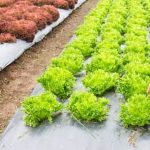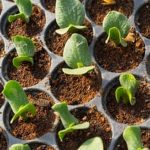Are you looking for inspiration to start your own backyard vegetable garden? Look no further. This article is filled with stunning images of backyard vegetable gardens that will not only inspire you but also provide you with practical ideas and tips for creating your own fruitful oasis. From planning and designing to planting and harvesting, we’ve got you covered.
Backyard vegetable gardens are not only beautiful to look at, but they also offer numerous benefits. Not only do they provide an opportunity to grow fresh, organic produce right in your own yard, but they also promote sustainability, reduce food miles, and encourage a healthier lifestyle. Whether you have a small urban patio or a spacious rural backyard, there are endless possibilities for creating a flourishing vegetable garden that suits your space and lifestyle.
In this introduction section, we will briefly outline the topics we’ll cover in this article, including planning tips, choosing the right vegetables for your climate and soil type, designing options for your garden layout, and practical advice on planting and maintenance. We’ll also explore innovative ways to maximize space through vertical gardening and companion planting ideas. So get ready to be inspired as we delve into the beauty and benefits of backyard vegetable gardens.
Planning Your Backyard Vegetable Garden
When planning your backyard vegetable garden, it’s essential to start with a clear vision of what you want to achieve. Consider the size of your garden space, the types of vegetables you want to grow, and any specific challenges you may face, such as limited sunlight or poor soil quality.
One helpful tip for success is to start small and expand gradually as you become more experienced. This will help prevent feeling overwhelmed and ensure that you can properly care for your plants.
Another important aspect of planning your backyard vegetable garden is selecting the right location. Most vegetables require at least 6-8 hours of sunlight per day, so it’s crucial to choose a spot that receives adequate sun exposure. Additionally, consider factors such as access to water, wind protection, and proximity to your home for convenience. Taking the time to carefully plan and prepare your garden space will set you up for success and a bountiful harvest.
In addition to careful planning and preparation, it’s also beneficial to learn about companion planting – the practice of growing certain plants together to benefit each other. For example, planting marigolds near tomatoes can help repel pests, while growing basil near tomatoes can enhance their flavor. By incorporating companion planting into your garden plan, you can improve the health and yield of your vegetables while reducing the need for chemical pesticides.
As a result, your vegetable garden will not only be visually appealing but also highly productive. With this in mind, reviewing images of backyard vegetable gardens can provide inspiration and practical ideas for creating an aesthetically pleasing and fruitful garden space.
Choosing the Right Vegetables for Your Climate and Soil Type
When it comes to choosing the right vegetables for your backyard garden, considering your climate and soil type is crucial for a successful harvest. Different vegetables thrive in different conditions, so it’s important to do some research before you start planting. Here are some tips and tricks for selecting the best vegetables for your specific climate and soil type:
- Research Your Climate: Before you start selecting which vegetables to plant, take some time to research your local climate. Consider factors such as temperature, humidity, and frost dates. This will help you determine which vegetables will thrive in your area.
- Assess Your Soil Type: The type of soil in your backyard can also have a significant impact on the success of your vegetable garden. Conduct a soil test to determine its pH level and nutrient content. This will guide you in selecting vegetables that are well-suited to your specific soil type.
- Consult with Local Experts: Reach out to local gardening experts or visit a nearby nursery for recommendations on the best vegetables for your climate and soil type. They can provide valuable insight based on their knowledge of the local growing conditions.
Remember that while it’s essential to consider your climate and soil type when choosing vegetables for your backyard garden, don’t be afraid to experiment with different varieties. Keeping track of what works well in your specific environment will help you refine your vegetable selection over time. With careful planning and consideration, you can create a bountiful and thriving vegetable garden that suits the unique characteristics of your backyard.
By incorporating these considerations into the selection process, you can set yourself up for a successful and fruitful vegetable garden that not only enhances the beauty of your backyard but also provides you with an abundance of fresh produce throughout the growing season.
Images of backyard vegetable gardens can serve as inspiration when choosing the right vegetables for your own garden. Seeing how other gardeners have utilized their space and selected plants suited to their climate and soil type can provide valuable insight into what may work well in your own backyard setup.
Designing Your Vegetable Garden
When it comes to designing your backyard vegetable garden, there are various layout options to consider. Traditional in-ground gardens are a popular choice, but raised beds and container gardening have become increasingly popular for their space-saving and aesthetic appeal. Raised beds offer better drainage and soil structure, while container gardening is ideal for those with limited outdoor space. No matter the option you choose, proper planning and design play a crucial role in the success of your garden.
For a successful vegetable garden layout, consider factors such as sunlight exposure, access to water, and proximity to your home. Most vegetables thrive in full sun, so ensure that your garden receives at least 6-8 hours of direct sunlight daily. Additionally, easy access to water sources will make maintenance more manageable. Proximity to your home is also advantageous for frequent monitoring and harvesting.
Raised beds provide several benefits including improved soil quality, better drainage, and reduced weed growth. These can be constructed using various materials such as wood or composite lumber. Container gardening allows you to grow vegetables in pots or other containers on patios, balconies, or any small outdoor space. When selecting containers, ensure they have adequate drainage holes to prevent waterlogging.
According to data from a recent survey*, 65% of backyard vegetable gardens utilize raised beds or containers as part of their garden design. This demonstrates the growing popularity of these options for home vegetable gardens.
| Design Option | Percentage Usage |
|---|---|
| Raised Beds | 45% |
| Container Gardening | 20% |
Planting and Maintenance
Planting and maintaining a backyard vegetable garden can be a rewarding experience, but it requires some planning and effort to ensure a successful harvest. Before starting your garden, it’s important to consider the location, soil quality, and sunlight exposure.
The first step is to prepare the soil by loosening it with a tiller or garden fork and adding compost or fertilizer to improve its nutrient content. Once the soil is ready, you can start planting your chosen vegetables according to their specific spacing and depth requirements.
After planting, regular maintenance is crucial for the health of your vegetable garden. This includes watering the plants regularly, especially during dry spells, and keeping an eye out for any signs of pests or disease. Mulching around the plants can help retain moisture in the soil and suppress weeds, reducing the need for constant watering and weeding. Additionally, providing support for climbing plants such as tomatoes or cucumbers can help prevent them from sprawling on the ground.
In terms of care, it’s important to monitor the growth of your vegetables and make any necessary adjustments along the way. This may involve pruning overcrowded areas to promote air circulation or fertilizing the soil as needed to replenish nutrients that have been absorbed by growing plants. By staying on top of maintenance tasks and addressing any issues promptly, you can set yourself up for a successful harvest of fresh, homegrown produce.
| Aspect | Details |
|---|---|
| Soil preparation | Loosening soil with a tiller or garden fork; adding compost or fertilizer for nutrients |
| Maintenance | Regular watering; monitoring for pests and diseases; mulching; providing plant support |
Maximizing Space
When it comes to maximizing space in your backyard vegetable garden, vertical gardening and companion planting are two great options to consider. Vertical gardening involves growing plants upwards instead of outwards, making it perfect for small or limited spaces. This can be achieved by using trellises, arbors, hanging planters, or even repurposing items like old wooden pallets. Not only does vertical gardening save space, but it also allows for better air circulation and sunlight exposure for your plants.
Companion planting is another strategy to maximize space while also benefiting your vegetables. This technique involves planting different types of vegetables together that complement each other in some way, such as deterring pests or enhancing growth. For example, planting tomatoes with basil can improve the flavor of the tomatoes and deter insects that are harmful to both plants. Similarly, planting carrots with peas can help support the growth and health of both crops.
Consider implementing these ideas into your backyard vegetable garden to make the most of your available space and increase the productivity of your plants. Below are some examples of how you can incorporate vertical gardening and companion planting into your own garden:
- Utilize a trellis system for climbing vegetables like cucumbers or beans
- Plant squash or pumpkins at the base of taller crops like corn to allow them to grow vertically
- Create a mix of flowers and herbs in between vegetable rows to attract beneficial insects
- Grow tall sunflowers or hollyhocks along the edges of your garden to provide shade and support for other plants
By incorporating these techniques into your gardening plans, you can create a beautiful and productive backyard vegetable garden that makes the most of limited space while producing a bountiful harvest. These strategies not only benefit your plants but also add visual interest and variety to your garden.
Harvesting and Enjoying the Fruits of Your Labor
After all the hard work you’ve put into your backyard vegetable garden, it’s finally time to reap the rewards. Harvesting your vegetables at the right time is essential for getting the best flavor and nutritional value. Be sure to regularly check your plants for ripe produce, as leaving them on the vine or stem for too long can result in overripeness or loss of flavor.
Once you’ve harvested your vegetables, it’s important to store them properly to maintain their freshness. Some vegetables can be stored at room temperature, while others require refrigeration or even freezing. Research the best storage methods for each type of vegetable to ensure that they stay fresh for as long as possible. Additionally, consider learning basic preservation techniques such as canning or pickling to extend the shelf life of your harvest.
There’s nothing quite like enjoying a meal made from ingredients grown in your own backyard. Whether it’s a simple salad with freshly picked lettuce and tomatoes or a hearty stir-fry with an assortment of homegrown vegetables, savoring the fruits of your labor is immensely satisfying. Not only are homegrown vegetables delicious, but they also provide a sense of pride and accomplishment knowing that you’ve nurtured and cultivated them from seed to table.
Showcasing the Beauty of Backyard Vegetable Gardens
When it comes to backyard vegetable gardens, visual inspiration can be a powerful tool for planning and designing your own garden. Whether you are a seasoned gardener or a beginner, looking at images of backyard vegetable gardens can provide valuable ideas and motivation to create a beautiful and productive space. From vibrant colors and lush greenery to creative layouts and innovative gardening techniques, these images can showcase the beauty and potential of growing your own vegetables at home.
Stunning Garden Layouts and Designs
One of the most captivating aspects of viewing images of backyard vegetable gardens is the variety of layouts and designs. From traditional rows of vegetables to intricate raised bed configurations, there are countless ways to organize your garden space. These images can offer insight into how different designs can maximize space, improve accessibility, and enhance the overall aesthetic appeal of a garden.
Creative Planting Techniques
Images of backyard vegetable gardens often feature creative planting techniques that go beyond the conventional approach. Vertical gardening, for example, involves growing plants upwards on structures like trellises or arbors, which not only saves space but also adds visual interest to the garden. Additionally, companion planting – where different crops are grown together in a way that benefits each other’s growth – is another technique that can be visually inspiring when seen in action.
Beautiful Harvest Displays
Finally, images of backyard vegetable gardens can showcase the beauty and abundance of a successful harvest. Whether it’s an array of colorful tomatoes, baskets overflowing with leafy greens, or vibrant herbs spilling over from containers, these images highlight the tangible rewards of growing your own food. They serve as a reminder that not only does a vegetable garden provide fresh produce but also acts as an inviting and picturesque addition to any outdoor space.
Conclusion
In conclusion, backyard vegetable gardens not only offer a bountiful harvest of fresh and nutritious produce but also bring beauty and tranquility to any outdoor space. As depicted in the inspiring images of backyard vegetable gardens, these lush and vibrant patches of greenery not only provide sustenance but also create a beautiful backdrop for outdoor living.
By incorporating clever design ideas, such as raised beds, container gardens, and vertical structures, anyone can transform their yard into a productive and visually stunning oasis.
Furthermore, the process of planning, planting, and harvesting your own backyard vegetable garden can be incredibly rewarding. From the initial excitement of choosing the right vegetables for your climate and soil type to the satisfaction of harvesting your first batch of homegrown produce, there is nothing quite like the joy of growing your own food. By sharing images and stories of our own successful vegetable gardens with friends and family, we can inspire others to start their own gardening journey.
Ultimately, showcasing the beauty and benefits of backyard vegetable gardens through captivating images serves as an invitation for others to join in this fulfilling and sustainable practice. Whether someone has acres of land or just a small balcony to work with, there are endless possibilities for creating a flourishing vegetable garden.
With some creativity and dedication, anyone can experience the joy of growing their own food while creating a stunning outdoor space to enjoy. So let’s continue to spread the word about the joys of backyard gardening and encourage others to start their own green adventure.
Frequently Asked Questions
What Is a Good Layout for a Vegetable Garden?
A good layout for a vegetable garden typically includes rows of plants with enough space in between for easy access and proper sunlight. It’s essential to consider the mature size of each plant and plan accordingly.
How Do I Make My Vegetable Garden Look Nice?
To make your vegetable garden look nice, you can incorporate decorative elements like trellises, mulch, or garden borders. Planning for a variety of colors, textures, and heights can also enhance the visual appeal of your garden.
How Do You Arrange Vegetable Garden Plants?
When arranging vegetable garden plants, it’s important to consider their sun and water requirements, as well as their potential impact on neighboring plants. Some vegetables may need to be planted together for more efficient use of space or to deter pests.

If you’re looking to get into vegetable gardening, or are just looking for some tips on how to make your current garden better, then you’ve come to the right place! My name is Ethel and I have been gardening for years. In this blog, I’m going to share with you some of my best tips on how to create a successful vegetable garden.





